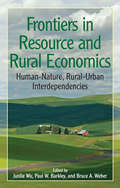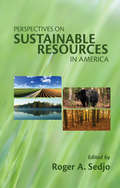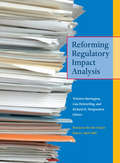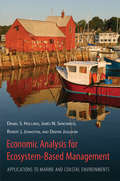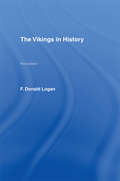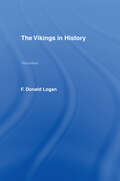- Table View
- List View
Frontiers in Resource and Rural Economics: "Human-Nature, Rural-Urban Interdependencies"
by Wu JunJie Paul W Barkley Bruce A WeberMost land in the United States is in rural areas, as are the sources of most of its fresh water and almost all its other natural resources. One of the first books to approach resource economics and rural studies as fundamentally interconnected areas of study, Frontiers in Resource and Rural Economics integrates the work of 18 leading scholars in resource economics, rural economics, rural sociology and political science in order to focus on two complex interdependencies-one pertaining to natural resources and human welfare, the other to urban and rural communities and their economies. The book reviews the past 50 years of scholarship in both natural resource and rural economics. It contrasts their different intellectual and practical approaches and considers how they might be refocused in light of pressing demands on human and natural systems. It then proposes a 'new rural economics' that acknowledges the full range of human-ecosystem and urban-rural interdependencies. It explores the relationship between natural resources and economic growth, and considers the prospects for amenity-driven growth that would benefit both new and traditional inhabitants of rural areas. Later chapters explore the politics of place, spatial economics, strategies for reducing rural poverty, and prospects for linking rural and environmental governance. Throughout, the book emphasizes innovative research methods that integrate natural resource, environmental, and rural economics.
Frontiers in Resource and Rural Economics: "Human-Nature, Rural-Urban Interdependencies"
by Wu JunJie Paul W Barkley Bruce A WeberMost land in the United States is in rural areas, as are the sources of most of its fresh water and almost all its other natural resources. One of the first books to approach resource economics and rural studies as fundamentally interconnected areas of study, Frontiers in Resource and Rural Economics integrates the work of 18 leading scholars in resource economics, rural economics, rural sociology and political science in order to focus on two complex interdependencies-one pertaining to natural resources and human welfare, the other to urban and rural communities and their economies. The book reviews the past 50 years of scholarship in both natural resource and rural economics. It contrasts their different intellectual and practical approaches and considers how they might be refocused in light of pressing demands on human and natural systems. It then proposes a 'new rural economics' that acknowledges the full range of human-ecosystem and urban-rural interdependencies. It explores the relationship between natural resources and economic growth, and considers the prospects for amenity-driven growth that would benefit both new and traditional inhabitants of rural areas. Later chapters explore the politics of place, spatial economics, strategies for reducing rural poverty, and prospects for linking rural and environmental governance. Throughout, the book emphasizes innovative research methods that integrate natural resource, environmental, and rural economics.
Small Firms and the Environment in Developing Countries: "Collective Impacts, Collective Action"
by Allen BlackmanSmall firms - including 'microenterprises' and 'small and medium enterprises' (SMEs) - play a vital economic role in developing countries. They typically provide half of all jobs. In addition, they foster entrepreneurship and help key sectors adapt to changing market conditions. In light of these benefits, programs promoting small firms have become a cornerstone of economic development policy. Increasingly, however, scholars and policymakers are also exploring the link between small firms and the environment. The first compendium of research and policy analysis on this topic, this book is organized around three questions: How important is small firm pollution? Will forcing small firms to comply with environmental regulations exacerbate unemployment and poverty? And what policy options are available to control small firm pollution? Eleven case studies from China, Ecuador, Honduras, India, Malaysia, and Mexico address these questions. They compare the environmental damages caused by small firms and large ones. They explore the positive and negative economic consequences of pollution control strategies focusing on small firms, the administrative challenges of regulating thousands of firms which are often unregistered and unknown to the government, and they describe innovative approaches for persuading small firms to implement effective pollution controls. The case studies cover a variety of industrial sectors including ceramics, leather tanning, textiles, and agro-industry, and evaluate a wide range of environmental management strategies that include encouraging collective action among small firms, creating economic incentives for pollution control, and helping small firms adopt clean technologies and environmental management systems. Many of the chapters are groundbreaking, addressing topics new to the literature?for example, the role of international trade in greening small firms, and funding small firm pollution control projects by linking them to efforts to stem global warming. Highly readable, Small Firms and the Environment in Developing Countries is a valuable text for courses in development policy and economics that have an environmental component or focus. It will also prove of interest to development workers, policymakers in developing countries, and students and scholars of environmental policy and law.
Small Firms and the Environment in Developing Countries: "Collective Impacts, Collective Action"
by Allen BlackmanSmall firms - including 'microenterprises' and 'small and medium enterprises' (SMEs) - play a vital economic role in developing countries. They typically provide half of all jobs. In addition, they foster entrepreneurship and help key sectors adapt to changing market conditions. In light of these benefits, programs promoting small firms have become a cornerstone of economic development policy. Increasingly, however, scholars and policymakers are also exploring the link between small firms and the environment. The first compendium of research and policy analysis on this topic, this book is organized around three questions: How important is small firm pollution? Will forcing small firms to comply with environmental regulations exacerbate unemployment and poverty? And what policy options are available to control small firm pollution? Eleven case studies from China, Ecuador, Honduras, India, Malaysia, and Mexico address these questions. They compare the environmental damages caused by small firms and large ones. They explore the positive and negative economic consequences of pollution control strategies focusing on small firms, the administrative challenges of regulating thousands of firms which are often unregistered and unknown to the government, and they describe innovative approaches for persuading small firms to implement effective pollution controls. The case studies cover a variety of industrial sectors including ceramics, leather tanning, textiles, and agro-industry, and evaluate a wide range of environmental management strategies that include encouraging collective action among small firms, creating economic incentives for pollution control, and helping small firms adopt clean technologies and environmental management systems. Many of the chapters are groundbreaking, addressing topics new to the literature?for example, the role of international trade in greening small firms, and funding small firm pollution control projects by linking them to efforts to stem global warming. Highly readable, Small Firms and the Environment in Developing Countries is a valuable text for courses in development policy and economics that have an environmental component or focus. It will also prove of interest to development workers, policymakers in developing countries, and students and scholars of environmental policy and law.
Perspectives on Sustainable Resources in America
by Roger A. SedjoThe vast size of the United States and extensive variation of its climate, topography, and biota across different regions contribute to both the richness of the nation?s natural heritage and the complexities involved in managing its resources. A follow-up to RFF?s popular America?s Renewable Resources (1990), Perspectives on Sustainable Resources in America updates readers about the current challenges involved in managing America?s natural resources, especially in light of the increasing emphasis on sustainability and ecosystem approaches to management. Written to inform general audiences and students, as well as to engage the interest of experts, the book includes assessments by some of the nation?s most renowned scholars in natural resource economics and policy. An introductory chapter critically examines the concept of sustainability as it has been developed in recent years and asks how the concept might apply to individual resource systems. It considers the interrelatedness of ecosystem, economic, and social sustainability; the paradigms of resource sufficiency and functional integrity; and the contrast between weak and strong sustainability. The chapters that follow examine America?s experience with forests, water, agricultural soils, and wildlife. Highlighting the adaptability and resilience of resource systems, each chapter provides a description of the physical characteristics of the resource, a history of its use, a policy history, and a review of ongoing debates in management and policy. Perspectives on Sustainable Resources in America concludes with an innovative treatment of biodiversity as a natural resource. The chapter reviews the definitions of biodiversity, the ecological and economic meanings of biodiversity, and current efforts to preserve biodiversity, especially through regulatory approaches.
Perspectives on Sustainable Resources in America
by Roger A. SedjoThe vast size of the United States and extensive variation of its climate, topography, and biota across different regions contribute to both the richness of the nation?s natural heritage and the complexities involved in managing its resources. A follow-up to RFF?s popular America?s Renewable Resources (1990), Perspectives on Sustainable Resources in America updates readers about the current challenges involved in managing America?s natural resources, especially in light of the increasing emphasis on sustainability and ecosystem approaches to management. Written to inform general audiences and students, as well as to engage the interest of experts, the book includes assessments by some of the nation?s most renowned scholars in natural resource economics and policy. An introductory chapter critically examines the concept of sustainability as it has been developed in recent years and asks how the concept might apply to individual resource systems. It considers the interrelatedness of ecosystem, economic, and social sustainability; the paradigms of resource sufficiency and functional integrity; and the contrast between weak and strong sustainability. The chapters that follow examine America?s experience with forests, water, agricultural soils, and wildlife. Highlighting the adaptability and resilience of resource systems, each chapter provides a description of the physical characteristics of the resource, a history of its use, a policy history, and a review of ongoing debates in management and policy. Perspectives on Sustainable Resources in America concludes with an innovative treatment of biodiversity as a natural resource. The chapter reviews the definitions of biodiversity, the ecological and economic meanings of biodiversity, and current efforts to preserve biodiversity, especially through regulatory approaches.
Emissions Trading: Principles and Practice
by Thomas H. TietenbergFirst published in 1985, Emissions Trading was a comprehensive review of the first large-scale attempt to use economic incentives in environmental policy in the U.S. and of the empirical and theoretical research on which this approach is based. Since its publication it has consistently been one of the most widely cited works in the tradable permits literature. The second edition of this classic study of pollution reform considers how the use of transferable permits to control pollution has evolved, looks at how these programs have been implemented in the U.S. and internationally, and offers an objective evaluation of the resulting successes, failures, and lessons learned over the last twenty-five years.
Emissions Trading: Principles and Practice
by Thomas H. TietenbergFirst published in 1985, Emissions Trading was a comprehensive review of the first large-scale attempt to use economic incentives in environmental policy in the U.S. and of the empirical and theoretical research on which this approach is based. Since its publication it has consistently been one of the most widely cited works in the tradable permits literature. The second edition of this classic study of pollution reform considers how the use of transferable permits to control pollution has evolved, looks at how these programs have been implemented in the U.S. and internationally, and offers an objective evaluation of the resulting successes, failures, and lessons learned over the last twenty-five years.
Private Rights in Public Resources: Equity and Property Allocation in Market-Based Environmental Policy
by Professor Leigh RaymondPrivatizing public resources by creating stronger property rights, including so-called rights to pollute, is an increasingly popular environmental policy option. While advocates of this type of market-based environmental policy tend to focus on its efficiency and ecological implications, such policies also raise important considerations of equity and distributive justice. Private Rights in Public Resources confronts these ethical implications directly, balancing political theory and philosophy with detailed analysis of the politics surrounding three important policy instruments--the Kyoto Protocol, the 1990 Clean Air Act Amendments, and the 1934 Taylor Grazing Act. Author Leigh Raymond reviews legislative records and administrative documents and interviews key policymakers. Confirming that much of the debate in the selected policies centers on the equity or fairness of the initial allocation of property rights, he applies the theories of John Locke, Morris Cohen, and others to build a framework for identifying the competing norms of equity in play. Raymond's study reveals that, despite the different historical and ecological settings, the political actors struggled to reconcile similar arguments-and were often able to achieve a similar synthesis of conflicting ownership ideas. Rather than offering a familiar argument for or against these policies on ethical grounds, the book explains how ideas about equity help determine a policy's political fate. Shedding light on the complex equity principles used to shape and evaluate these controversial initiatives, this empirical analysis will be of interest to those on all sides of the debate over market-based policies, as well as those interested in the role of normative principles in politics more generally.
Private Rights in Public Resources: Equity and Property Allocation in Market-Based Environmental Policy
by Professor Leigh RaymondPrivatizing public resources by creating stronger property rights, including so-called rights to pollute, is an increasingly popular environmental policy option. While advocates of this type of market-based environmental policy tend to focus on its efficiency and ecological implications, such policies also raise important considerations of equity and distributive justice. Private Rights in Public Resources confronts these ethical implications directly, balancing political theory and philosophy with detailed analysis of the politics surrounding three important policy instruments--the Kyoto Protocol, the 1990 Clean Air Act Amendments, and the 1934 Taylor Grazing Act. Author Leigh Raymond reviews legislative records and administrative documents and interviews key policymakers. Confirming that much of the debate in the selected policies centers on the equity or fairness of the initial allocation of property rights, he applies the theories of John Locke, Morris Cohen, and others to build a framework for identifying the competing norms of equity in play. Raymond's study reveals that, despite the different historical and ecological settings, the political actors struggled to reconcile similar arguments-and were often able to achieve a similar synthesis of conflicting ownership ideas. Rather than offering a familiar argument for or against these policies on ethical grounds, the book explains how ideas about equity help determine a policy's political fate. Shedding light on the complex equity principles used to shape and evaluate these controversial initiatives, this empirical analysis will be of interest to those on all sides of the debate over market-based policies, as well as those interested in the role of normative principles in politics more generally.
Reforming Regulatory Impact Analysis
by Winston Harrington Lisa Heinzerling Richard D MorgensternOver the past decades, considerable debate has emerged surrounding the use of cost-benefit analysis (CBA) to analyze and make recommendations for environmental and safety regulations. Critics argue that CBA forces values on unquantifiable factors, that it does not adequately measure benefits across generations, and that it is not adaptable in situations of uncertainty. Proponents, on the other hand, believe that a well-done CBA provides useful, albeit imperfect, information to policymakers precisely because of the standard metrics that are applied across the analysis. Largely absent from the debate have been practical questions about how the use of CBA could be improved. Relying on the assumption that CBA will remain an important component in the regulatory process, this new work from Resources for the Future brings together experts representing both sides of the debate to analyze the use of CBA in three key case studies: the Clean Air Interstate Rule, the Clean Air Mercury Rule, and the Cooling Water Intake Structure Rule (Phase II). Each of the case studies is accompanied by critiques from both an opponent and a proponent of CBA and includes consideration of complementary analyses that could have been employed. The work's editors - two CBA supporters and one critic - conclude the report by offering concrete recommendations for improving the use of CBA, focusing on five areas: technical quality of the analyses, relevance to the agency decision-making process, transparency of the analyses, treatment of new scientific findings, and balance in both the analyses and associated processes, including the treatment of distributional consequences.
Reforming Regulatory Impact Analysis
by Winston Harrington Lisa Heinzerling Richard D MorgensternOver the past decades, considerable debate has emerged surrounding the use of cost-benefit analysis (CBA) to analyze and make recommendations for environmental and safety regulations. Critics argue that CBA forces values on unquantifiable factors, that it does not adequately measure benefits across generations, and that it is not adaptable in situations of uncertainty. Proponents, on the other hand, believe that a well-done CBA provides useful, albeit imperfect, information to policymakers precisely because of the standard metrics that are applied across the analysis. Largely absent from the debate have been practical questions about how the use of CBA could be improved. Relying on the assumption that CBA will remain an important component in the regulatory process, this new work from Resources for the Future brings together experts representing both sides of the debate to analyze the use of CBA in three key case studies: the Clean Air Interstate Rule, the Clean Air Mercury Rule, and the Cooling Water Intake Structure Rule (Phase II). Each of the case studies is accompanied by critiques from both an opponent and a proponent of CBA and includes consideration of complementary analyses that could have been employed. The work's editors - two CBA supporters and one critic - conclude the report by offering concrete recommendations for improving the use of CBA, focusing on five areas: technical quality of the analyses, relevance to the agency decision-making process, transparency of the analyses, treatment of new scientific findings, and balance in both the analyses and associated processes, including the treatment of distributional consequences.
Economic Analysis for Ecosystem-Based Management: Applications to Marine and Coastal Environments
by Daniel Holland James Sanchirico Robert Johnston Deepak JoglekaOcean and coastal management regimes are increasingly subject to competing demands from stakeholders. Regulations must not only address fishing, recreation, and shipping, but also sand and gravel mining, gas pipelines, harbor/port development, offshore wind and tidal energy facilities, liquefied natural gas terminals, offshore aquaculture, and desalinization plants. The growing variety and intensity of ocean and coastal uses increases the call for a more holistic, comprehensive, and coordinated management approach that recognizes the often complex relationships between natural and human systems. For both economist and non-economist audiences, this book describes ways in which economic analysis can be an important tool to inform and improve ecosystem-based management (EBM). Topics include modeling economic impacts, benefit-cost analysis, spatial considerations in EBM, incentives and human behaviors, and accounting for uncertainty in policy analysis. Throughout the book the authors elucidate the different kinds of insights which can be gained from the use of different economic tools. In this rigorous and accessible work, the authors defy the conventional stereotype that economic perspectives necessarily favor the greatest commercial development. Instead, they demonstrate how comprehensive economic analyses consider the full range of potential services offered by marine and coastal ecosystems, including the conservation of biodiversity and creation of recreational opportunities.
Economic Analysis for Ecosystem-Based Management: Applications to Marine and Coastal Environments
by Daniel Holland James Sanchirico Robert Johnston Deepak JoglekaOcean and coastal management regimes are increasingly subject to competing demands from stakeholders. Regulations must not only address fishing, recreation, and shipping, but also sand and gravel mining, gas pipelines, harbor/port development, offshore wind and tidal energy facilities, liquefied natural gas terminals, offshore aquaculture, and desalinization plants. The growing variety and intensity of ocean and coastal uses increases the call for a more holistic, comprehensive, and coordinated management approach that recognizes the often complex relationships between natural and human systems. For both economist and non-economist audiences, this book describes ways in which economic analysis can be an important tool to inform and improve ecosystem-based management (EBM). Topics include modeling economic impacts, benefit-cost analysis, spatial considerations in EBM, incentives and human behaviors, and accounting for uncertainty in policy analysis. Throughout the book the authors elucidate the different kinds of insights which can be gained from the use of different economic tools. In this rigorous and accessible work, the authors defy the conventional stereotype that economic perspectives necessarily favor the greatest commercial development. Instead, they demonstrate how comprehensive economic analyses consider the full range of potential services offered by marine and coastal ecosystems, including the conservation of biodiversity and creation of recreational opportunities.
Environmental Protection and the Social Responsibility of Firms: "Perspectives from Law, Economics, and Business"
by Bruce L. Hay Robert N. Stavins Richard H. VietorEveryone agrees that firms should obey the law. But beyond what the law requires-beyond bare compliance with regulations-do firms have additional social responsibilities to commit resources voluntarily to environmental protection? How should we think about firms sacrificing profits in the social interest? Are they permitted to do so, given their fiduciary responsibilities to their shareholders? Even if permissible, is the practice sustainable, or will the competitive marketplace render such efforts and their impacts transient at best? Furthermore, is the practice, however well intended, an efficient use of social and economic resources? And, as an empirical matter, to what extent do firms already behave this way? Until now, public discussion has generated more heat than light on both the normative and positive questions surrounding corporate social responsibility (CSR) in the environmental realm. In Environmental Protection and the Social Responsibility of Firms, some of the nation?s leading scholars in law, economics, and business examine commonly accepted assumptions at the heart of current debates on corporate social responsibility and provide a foundation for future research and policymaking.
Environmental Protection and the Social Responsibility of Firms: "Perspectives from Law, Economics, and Business"
by Bruce L. Hay Robert N. Stavins Richard H. VietorEveryone agrees that firms should obey the law. But beyond what the law requires-beyond bare compliance with regulations-do firms have additional social responsibilities to commit resources voluntarily to environmental protection? How should we think about firms sacrificing profits in the social interest? Are they permitted to do so, given their fiduciary responsibilities to their shareholders? Even if permissible, is the practice sustainable, or will the competitive marketplace render such efforts and their impacts transient at best? Furthermore, is the practice, however well intended, an efficient use of social and economic resources? And, as an empirical matter, to what extent do firms already behave this way? Until now, public discussion has generated more heat than light on both the normative and positive questions surrounding corporate social responsibility (CSR) in the environmental realm. In Environmental Protection and the Social Responsibility of Firms, some of the nation?s leading scholars in law, economics, and business examine commonly accepted assumptions at the heart of current debates on corporate social responsibility and provide a foundation for future research and policymaking.
The Vikings in History
by F. Donald LoganCompletely updated to include important primary research, archaeological findings and debates from the last decade, this third edition of F. Donald Logan's successful book examines the Vikings and their critical role in history. The author uses archaeological, literary and historical evidence to analyze the Vikings' overseas expeditions and their transformation from raiders to settlers. Focusing on the period from 800–1050, it studies the Vikings across the world, from Denmark and Sweden right across to the British Isles, the North Atlantic and the New World. This edition includes: a new epilogue explaining the aims of the book updated further reading sections maps and photographs. By taking this new archaeological and primary research into account, the author provides a vital text for history students and researchers of this fascinating people.
The Vikings in History
by F. Donald LoganCompletely updated to include important primary research, archaeological findings and debates from the last decade, this third edition of F. Donald Logan's successful book examines the Vikings and their critical role in history. The author uses archaeological, literary and historical evidence to analyze the Vikings' overseas expeditions and their transformation from raiders to settlers. Focusing on the period from 800–1050, it studies the Vikings across the world, from Denmark and Sweden right across to the British Isles, the North Atlantic and the New World. This edition includes: a new epilogue explaining the aims of the book updated further reading sections maps and photographs. By taking this new archaeological and primary research into account, the author provides a vital text for history students and researchers of this fascinating people.
Smog Check: "Science, Federalism, and the Politics of Clean Air"
by Douglas S. EisingerWhen federal and state governments battle over environmental regulations, whose approach should prevail? Shortly after passage of the 1990 Clean Air Act Amendments, a controversial U.S. EPA mandate led to an intense conflict between federal regulators and California politicians. The disagreement pitted EPA's required overhaul of auto inspections against California's desire to self-govern its test program - popularly called 'Smog Check.' The conflict nearly upended the Clean Air Act, and triggered dramatic policy shifts throughout the United States. Smog Check presents these struggles in first-hand detail. Eisinger, an EPA official at the time of this conflict, probes deeply into the issues and explores broader questions including: when does it become imperative for agencies to bargain with one another, when should regulatory flexibility and performance-based regulations be favored over command and control approaches, and what should be done when decisions need to be made in the face of scientific disagreement? The book also includes insightful commentary from other EPA participants in the Smog Check controversy. Smog Check's lessons will be relevant to climate change, air pollution control, and numerous other policy challenges.
Smog Check: "Science, Federalism, and the Politics of Clean Air"
by Douglas S. EisingerWhen federal and state governments battle over environmental regulations, whose approach should prevail? Shortly after passage of the 1990 Clean Air Act Amendments, a controversial U.S. EPA mandate led to an intense conflict between federal regulators and California politicians. The disagreement pitted EPA's required overhaul of auto inspections against California's desire to self-govern its test program - popularly called 'Smog Check.' The conflict nearly upended the Clean Air Act, and triggered dramatic policy shifts throughout the United States. Smog Check presents these struggles in first-hand detail. Eisinger, an EPA official at the time of this conflict, probes deeply into the issues and explores broader questions including: when does it become imperative for agencies to bargain with one another, when should regulatory flexibility and performance-based regulations be favored over command and control approaches, and what should be done when decisions need to be made in the face of scientific disagreement? The book also includes insightful commentary from other EPA participants in the Smog Check controversy. Smog Check's lessons will be relevant to climate change, air pollution control, and numerous other policy challenges.
True Warnings and False Alarms: "Evaluating Fears about the Health Risks of Technology, 1948-1971"
by Allan MazurGiven time, scientists reach consensus about the truth or falsity of a wide range of alleged hazards. Today, there is broad agreement that CFCs destroy stratospheric ozone. On the other hand, research does not support claims that electromagnetic fields from transmission lines cause a noticeable increase of leukemia. But new allegations continuously arise. Are manufactured chemicals in the environment distorting normal hormonal processes in our bodies? Are genetically modified foods a cause for concern? Addressing one of the most vexing problems in risk policy, Allan Mazur asks how we can tell, at an early stage, how seriously we should take a new warning. To identify hallmarks that could help predict the truth or falsity of an alleged hazard, Mazur analyzes 31 health warnings raised during the 1950s and 1960s about diverse technologies, including fluoridation, DDT, cyclamate, nuclear weapons testing, and birth control pills. Among his considerations are the initial source of an alarm, the biases held by its primary 'sponsors,' and the type of media coverage it receives. With 30 to 50 years of hindsight, he identifies characteristics - apparent from the outset of a controversy - that most effectively distinguish true warnings from false alarms. Early recognition and a timely response to a genuine hazard are important to protect our environment, health, and economic well-being. But if we act quickly and a warning turns out to be false, money is wasted, people are needlessly frightened, regulators lose credibility, and our ability to appropriately handle the next set of risks is compromised. Mazur's findings do not provide certainty about which of today's warnings will prove true and which will prove false. But they do help us to make informed judgments about where it is best and most reasonable to direct our worries and resources.
True Warnings and False Alarms: "Evaluating Fears about the Health Risks of Technology, 1948-1971"
by Allan MazurGiven time, scientists reach consensus about the truth or falsity of a wide range of alleged hazards. Today, there is broad agreement that CFCs destroy stratospheric ozone. On the other hand, research does not support claims that electromagnetic fields from transmission lines cause a noticeable increase of leukemia. But new allegations continuously arise. Are manufactured chemicals in the environment distorting normal hormonal processes in our bodies? Are genetically modified foods a cause for concern? Addressing one of the most vexing problems in risk policy, Allan Mazur asks how we can tell, at an early stage, how seriously we should take a new warning. To identify hallmarks that could help predict the truth or falsity of an alleged hazard, Mazur analyzes 31 health warnings raised during the 1950s and 1960s about diverse technologies, including fluoridation, DDT, cyclamate, nuclear weapons testing, and birth control pills. Among his considerations are the initial source of an alarm, the biases held by its primary 'sponsors,' and the type of media coverage it receives. With 30 to 50 years of hindsight, he identifies characteristics - apparent from the outset of a controversy - that most effectively distinguish true warnings from false alarms. Early recognition and a timely response to a genuine hazard are important to protect our environment, health, and economic well-being. But if we act quickly and a warning turns out to be false, money is wasted, people are needlessly frightened, regulators lose credibility, and our ability to appropriately handle the next set of risks is compromised. Mazur's findings do not provide certainty about which of today's warnings will prove true and which will prove false. But they do help us to make informed judgments about where it is best and most reasonable to direct our worries and resources.
Extending the Cure: Policy Responses to the Growing Threat of Antibiotic Resistance
by Ramanan Professor Laxminarayan Anup Professor Malani David Professor Howard David L. SmithOur ability to treat common bacterial infections with antibiotics goes back only 65 years. However, the authors of this report make it clear that sustaining a supply of effective and affordable antibiotics cannot be without changes to the incentives facing patients, physicians, hospitals, insurers, and pharmaceutical manufacturers. In fact, increasing resistance to these drugs is already exacting a terrible price. Every day in the United States, approximately 172 men, women, and children die from infections caused by antibiotic-resistant bacteria in hospitals alone. Beyond those deaths, antibiotic resistance is costing billions of dollars through prolonged hospital stays and the need for doctors to resort to ever more costly drugs to use as substitute treatments. Extending the Cure presents the problem of antibiotic resistance as a conflict between individual decision makers and their short-term interest and the interest of society as a whole, in both present and future: The effort that doctors make to please each patient by prescribing a drug when it might not be properly indicated, poor monitoring of discharged patients to ensure that they do not transmit drug-resistant pathogens to other persons, excesses in the marketing of new antibiotics, and the broad overuse of antibiotics all contribute to the development and spread of antibiotic-resistant bacteria. The book explores a range of policy options that would encourage patients, health care providers, and managed care organizations to serve as more responsible stewards of existing antibiotics as well as proposals that would give pharmaceutical firms greater incentives to develop new antibiotics and avoid overselling. If the problem continues unaddressed, antibiotic resistance has the potential to derail the health care system and return us to a world where people of all ages routinely die from simple infections. As a basis for future research and a spur to a critically important dialogue, Extending the Cure is a fundamental first step in addressing this public health crisis. The Extending the Cure project is funded in part by the Robert Wood Johnson Foundation through its Pioneer Portfolio.
Extending the Cure: Policy Responses to the Growing Threat of Antibiotic Resistance
by Ramanan Professor Laxminarayan Anup Professor Malani David Professor Howard David L. SmithOur ability to treat common bacterial infections with antibiotics goes back only 65 years. However, the authors of this report make it clear that sustaining a supply of effective and affordable antibiotics cannot be without changes to the incentives facing patients, physicians, hospitals, insurers, and pharmaceutical manufacturers. In fact, increasing resistance to these drugs is already exacting a terrible price. Every day in the United States, approximately 172 men, women, and children die from infections caused by antibiotic-resistant bacteria in hospitals alone. Beyond those deaths, antibiotic resistance is costing billions of dollars through prolonged hospital stays and the need for doctors to resort to ever more costly drugs to use as substitute treatments. Extending the Cure presents the problem of antibiotic resistance as a conflict between individual decision makers and their short-term interest and the interest of society as a whole, in both present and future: The effort that doctors make to please each patient by prescribing a drug when it might not be properly indicated, poor monitoring of discharged patients to ensure that they do not transmit drug-resistant pathogens to other persons, excesses in the marketing of new antibiotics, and the broad overuse of antibiotics all contribute to the development and spread of antibiotic-resistant bacteria. The book explores a range of policy options that would encourage patients, health care providers, and managed care organizations to serve as more responsible stewards of existing antibiotics as well as proposals that would give pharmaceutical firms greater incentives to develop new antibiotics and avoid overselling. If the problem continues unaddressed, antibiotic resistance has the potential to derail the health care system and return us to a world where people of all ages routinely die from simple infections. As a basis for future research and a spur to a critically important dialogue, Extending the Cure is a fundamental first step in addressing this public health crisis. The Extending the Cure project is funded in part by the Robert Wood Johnson Foundation through its Pioneer Portfolio.
Siren Song: Chilean Water Law As a Model for International Reform
by Carl J. BauerIncreasing scarcity, conflict, and environmental damage are critical features of the global water crisis. As governments, international organizations, NGOs, and corporations have tried to respond, Chilean water law has seemed an attractive alternative to older legislative and regulatory approaches. Boldly introduced in 1981, the Chilean model is the world?s leading example of a free market approach to water law, water rights, and water resource management. Despite more than a decade of international debate, however, a comprehensive, balanced account of the Chilean experience has been unavailable. Siren Song is an interdisciplinary analysis combining law, political economy, and geography. Carl Bauer places the Chilean model of water law in international context by reviewing the contemporary debate about water economics and policy reform. He follows with an account of the Chilean experience, drawing on primary and secondary sources in Spanish and English, including interviews with key people in Chile. He presents the debate about reforming the law after Chile?s 1990 return to democratic government, as well as emerging views about how water markets have worked in practice. The resulting book provides insights about law, economics, and public policy within Chile and lessons for the countries around the world that are wrestling with the challenges of water policy reform.
